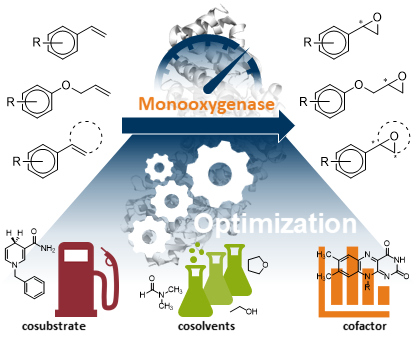EnzymoGenius™, our advanced enzyme AI design platform, explores cutting-edge design solutions related to AI-driven enzyme design, which has been tailored to advance scientific research in drug synthesis and biomanufacturing.
Background
Monooxygenases, a class of enzymes belonging to the oxidoreductase family, are instrumental in catalyzing various chemical reactions essential for drug synthesis and biomanufacturing. They possess the unique ability to introduce a single oxygen atom into a substrate molecule, thus facilitating the creation of intricate chemical compounds with precision. Their role extends to the synthesis of pharmaceutical intermediates, biofuels, and specialty chemicals, making them invaluable in modern industries.
 Fig 1. Optimization of monooxygenases. (Eggerichs D, et al., 2020)
Fig 1. Optimization of monooxygenases. (Eggerichs D, et al., 2020)
The advent of Artificial Intelligence has revolutionized the design and optimization of monooxygenases. AI algorithms, guided by vast datasets and advanced computational tools, enable the customization of these enzymes with unparalleled precision. Through machine learning, genetic algorithms, and molecular modeling, AI can predict and enhance enzyme properties, ultimately tailoring them to specific applications.
Products and Solutions Offering
High-quality Ketoreductases
We provide a comprehensive selection of monooxygenases, which include but are not limited to:
- Cytochrome P450 Monooxygenases. We offer a wide range of cytochrome P450 monooxygenases, each tailored to specific substrate preferences and reaction conditions. These versatile enzymes are essential for various biotransformation processes.
- Baeyer-Villiger Monooxygenases. Explore our selection of baeyer-villiger monooxygenases for efficient lactone and ester transformations.
- Rieske Non-Heme Iron Monooxygenases. Harness the power of rieske non-heme Iron monooxygenases for challenging oxygenation reactions. These enzymes are invaluable in the biocatalytic synthesis of complex molecules.
Custom Solutions
- Enzyme Selection. Expert guidance in choosing the right enzyme for your project.
- Reaction Optimization. Fine-tuning parameters for enhanced yields and efficiency.
- Pathway Design. Crafting optimal pathways for complex synthesis.
- Bioprocess Development. Streamlined processes for scale-up and biomanufacturing.
Process for AI Design of Monooxygenases
1. Data Collection and Analysis. AI gathers comprehensive data on monooxygenases, including genetic sequences, structures, and properties.
2. Algorithmic Design. Advanced algorithms model and simulate monooxygenase behavior, identifying key structural motifs and catalytic sites.
3. Optimization. AI refines enzyme properties by modifying their structure for improved substrate specificity, reaction rates, and stability.
4. Validation and Testing. Designed monooxygenases undergo rigorous in silico and in vitro testing to ensure functionality.
5. Iterative Refinement. The AI process iteratively improves enzyme design based on real-world performance feedback.
Our Technologies Advantages
- Machine Learning Algorithms
Leveraging AI to predict enzyme behavior.
Advantage: Rapid enzyme design and optimization.
- High-Throughput Screening
Identifying superior biocatalysts efficiently.
Advantage: Time and resource savings in enzyme selection.
- Protein Engineering Techniques
Tailoring enzymes for specific tasks.
Advantage: Precise control over catalytic properties.
- Synthetic Biology Approaches
Designing novel pathways for synthesis.
Advantage: Enhanced versatility in biomanufacturing.
Our AI-optimized monooxygenase products are at the forefront of this revolution, offering tailored solutions to meet the evolving demands of diverse industries. Contact us to explore how our AI-designed enzymes can elevate your scientific research and advance the frontiers of biocatalysis.
Reference
- Eggerichs, D.; et al. Enantioselective epoxidation by flavoprotein monooxygenases supported by organic solvents. Catalysts. 2020, 10(5):568.

































 Fig 1. Optimization of monooxygenases. (Eggerichs D, et al., 2020)
Fig 1. Optimization of monooxygenases. (Eggerichs D, et al., 2020)